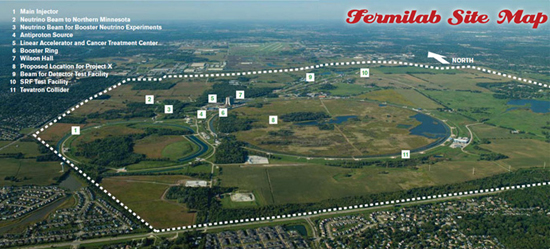Fermilab Particle Smasher Shut Down Permanently
An era ended last week as Fermilab closed down its Tevatron particle accelerator in a festive ceremony permanently.

The Tevatron had been at the frontier of high-energy particle physics for more than 28 years, but was recently surpassed by CERN's LHC, which offers a higher energy level for particle collisions and enables physicists to deliver results the Tevatron could never achieve. Science talent is now flocking to the LHC and the Tevatron had a tough time attracting the brightest minds of the scientific world.
The Tevatron was turned on on July 3, 1983, when it accelerated protons to 0.51 TeV (tera electron volts). Until the day of its shutdown, the Tevatron remained the world's highest-energy proton-antiproton collider with a combined collision energy level of 1.7 TeV (the LHC runs proton-proton collision experiments). Fermilab staff stresses that, while the Tevatron was Fermilab's main attraction, the lab will remain a leading research provider in other areas of high-energy and high-intensity physics, including neutrino research.
There are plans at Fermilab to reclaim the crown of the world's most capable particle accelerator. While there are different plans that would enable different kinds of experiments down the road, Fermilab scientists hope they can win funding for the long-planned International Linear Collider (ILC), which would be located partially on the 6800-acre Fermilab site in Batavia, Illinois, but stretch to a length of more than eight miles in length and run 300 feet below the ground (underneath neighboring towns). There is no clear idea how much the ILC could cost, but the latest numbers coming out of Fermilab put the price tag at more than $20 billion.
Get instant access to breaking news, the hottest reviews, great deals and helpful tips.
Wolfgang Gruener is Director, digital strategy and content experience at American Eagle, where he specializes in strategic data analysis, user behavior models and information architecture (IA), as well as content strategy and governance. He was also Managing Editor of the website TG Daily and contributor to sites including Tom's Guide and Tom's Hardware.
-
michalmierzwa Does this mean they will recycle the old parts and reduce cost of upcoming project?Reply -
doive1231 Does this mean they don't want us to know that muon neutrinos can travel faster than light as it means they'll be jobless and look even more clueless than normal?Reply -
aaron88_7 mouse24looks like john titor is getting more and more correct everydayExcept all that stuff about a civil ware breaking out in 2008....yea that guy was spot on!!Reply -
blubbey doive1231Does this mean they don't want us to know that muon neutrinos can travel faster than light as it means they'll be jobless and look even more clueless than normal?No. It means that they're decomissioning an almost 30 year old accelerator.Reply
Since when did scientists/science say they had all the answers? They stick with the theory that has the most evidence and which has the least doubt. Like, before they could prove atoms (protons/neutrons) existed they thought of the 'plumb pudding' model instead of the nucleus and the solid state theory of the universe. How can you expect to know everything straight away before anyone knows about it or it's discovered? Stop acting like you're better than everyone and share with us the secrets of faster than light travel! -
cats_Paw Well, so far it seems the world did not end becouse o f those gadgets that they are having fun with.Reply
I do have to say that 20 billion seems a bit expensive for a bunch of brains to have fun with something that we probably wont be using for decades :D.
Anyway, i only hope that if they create a black hole or some shit like that, that they will warn us first.
I wouldent want to miss the action. -
Incompetence of the US in managing science & space programs is the sign of the decline of USA.Reply
Nalliah Thayabharan -
enforcer22 ThayabharanIncompetence of the US in managing science & space programs is the sign of the decline of USA.Nalliah ThayabharanReply
you mean the over aged programs sucking money with no real use anymore? There is a new space program coming (Im only assuming you mean manned space program) and apparently a new accelerator program in the works.
